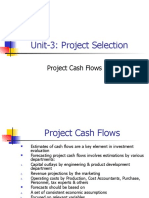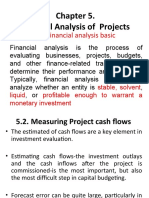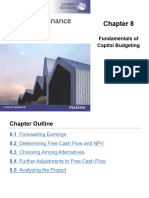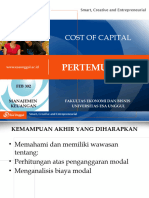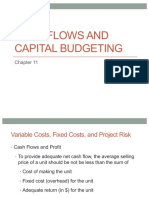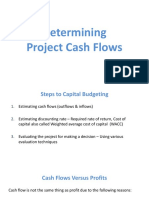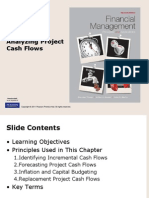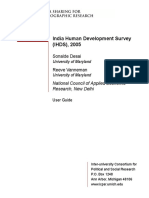4 - Cash Flow Estimation
4 - Cash Flow Estimation
Uploaded by
destinyrocks88Copyright:
Available Formats
4 - Cash Flow Estimation
4 - Cash Flow Estimation
Uploaded by
destinyrocks88Original Description:
Original Title
Copyright
Available Formats
Share this document
Did you find this document useful?
Is this content inappropriate?
Copyright:
Available Formats
4 - Cash Flow Estimation
4 - Cash Flow Estimation
Uploaded by
destinyrocks88Copyright:
Available Formats
02-Dec-13
1
1
Estimating Project Costs & Benefits:
Basic Principles
2
Basic Principles
In order to evaluate any Investment project, its costs &
benefits have to be estimated.
While estimating the costs and benefits, the following
principles have to be considered.
1. Cash Flow Principle
2. Incremental Principle
3. Consistency Principle
4. Interest exclusion Principle (Separation Principle)
5. Post-tax Principle
Estimating Project Costs & Benefits
02-Dec-13
2
3
Cash Flow Principle
Costs & Benefits must be measured in terms of Cash Flows
Profits are based on Accrual Concept:
Revenues are recognized when they are earned not when cash is received.
Expenses are recognized when they become due & not when paid.
Expenditure are classified as Revenue & Capital:
Revenue expenditure is entirely charged
Capital expenditure is capitalized & depreciated over economic life.
Cash Flows are superior than Revenues & Expenses
In operational terms: Add back Depreciation & other non-cash
charges, which were deducted while computing Accounting
profits, as they do not result in cash outflows.
Cash Flow = PAT + Depreciation & other non-cash charges
Estimating Project Costs & Benefits
4
PAT Vs. Cash Flow
Income Statement Cash Flow
Sales Revenue 1,000.0 Inflow 1,000.0
Less: Cost of Sales 640.0 Outflow 640.0
EBDIT 360.0
Less: Depreciation 50.0 Non-Cash
EBIT 310.0
Less: Interest 40.0 Outflow 40.0
PBT 270.0
Less Taxes @35% 94.5 Outflow 94.5
PAT 175.5 Net Cash Flow 225.5
Cash Flow = PAT + Depreciation
225.5 = 175.5 + 50.0
Estimating Project Costs & Benefits
02-Dec-13
3
5
Incremental Principle
Cash Flows must be measured in Incremental terms -changes in
cash flows due to the proposed project are relevant.
Project CF = CF of FIRM WITH project - CF of FIRM WITHOUT project
1. Consider all incidental effects: Project may improve or reduce the
profitability of existing operations. Complementary vs.
Competitive relationships with existing products need to be
analyzed.
Product cannibalization
In a Highly Competitive scenario, product cannibalization
will occur anyway, hence no need to factor in.
In businesses with entry barriers, such impact need to be
factored in. (present value of lost post-tax profits)
Synergies with existing businesses
Estimating Project Costs & Benefits
6
Incremental Principle
2. Ignore Sunk costs: Sunk costs are expenditure already incurred
on the project, prior to project analysis which cannot be
recovered. It is not affected by acceptance or rejection of the
project under consideration.
Cost of Old machine in a replacement decision.
Cost of Test Marketing, prior to conducting full-blown
investment analysis.
R & D costs.
Preliminary / pre-operative expenses are not sunk costs.
(Capitalized and written-off)
Estimating Project Costs & Benefits
02-Dec-13
4
7
Incremental Principle (Contd.)
3. Include Opportunity Costs: If a project uses resources already
available with the firm, the opportunity cost of such resources
should be charged to the project.
Is there any alternative use of the resources if the project is not
undertaken ?
Compare with vs. without and not before vs. after
Scenario A: Resources have current alternative uses:
Analyze the alternative uses and factor in the opportunity costs:
Resources may be rented Lost rental income
Resources may be sold sale price net of taxes & lost depreciation tax
shield
Resources may be used elsewhere in the firmcost of replacing
Scenario B: Resources have no current alternative use, but the firm
has to forgo the alternative uses in the future. E.g.. Excess
Capacity
Estimating Project Costs & Benefits
8
Incremental Principle (Contd.)
4. Question the Allocation of Overheads: Overhead cost are costs
which are indirectly related to a product.- Administrative, Legal
expenses etc.
Overhead costs are allocated (Spread over) over various
products.
What matters is the incremental overhead cost
attributable to the project & not allocated overhead costs.
5. Include Working Capital Requirements: NWC=CA-CL.
Besides the initial investment in Plant & Equipment, projects also
require additional investment in working capital, which must be
recognized in cash flows.
Requirement of NWC is likely to change over time, which must
also be factored in.
On project termination, working capital is released, which must
be treated as cash inflow.
Estimating Project Costs & Benefits
02-Dec-13
5
9
Interest exclusion Principle
Cost of Long term debt should be excluded from the estimation
of Cash Flows
Interest on Long term debt may be reflected by:
Charging interest on Long term debt from Profit OR
Discounting the Cash Flows by WACC, which includes cost of
debt as well
If interest on Long term debt is considered in Cash Flows and the
same is discounted @ WACC, then cost of debt is being
considered twice.
In operational terms:
Exclude Interest on Long-term debt, or
If interest on debt has been deducted while calculating PAT, then
Interest *(1-tax rate) should be added back to PAT.
Estimating Project Costs & Benefits
10
Interest exclusion Principle (contd.)
Particulars A B
EBDIT 1000 1000
Depreciation 50 50
EBIT 950 950
Interest 100 -
PBT 850 950
Taxes @ 30% 255 285
PAT 595 665
Cash Flow
595+50+100*(1-0.30) = 715
665+50=715
EBIT*(1-tax rate) = (PBT+ Interest) * (1-tax rate)
= PBT*(1-tax rate) + Interest*(1-tax rate)
= PAT + Interest*(1-tax rate)
Estimating Project Costs & Benefits
02-Dec-13
6
11
Post-tax Principle
Cash Flows should be measured on aftertax basis.
Similarly, cost of Capital should also be on post-tax basis.
Consider the marginal rate of tax (not average)
Treatment of Losses:
Case Project Firm Treatment
1 Profits Profits Consider Taxes in each year
2 Losses Profits Take tax savings in year of loss
3 Profits Losses Defer taxes until firm makes profits
4 Losses Losses Defer Tax Savings
5
(Stand Alone)
Losses __ Defer Tax savings until project makes
profits
Estimating Project Costs & Benefits
12
Consistency Principle
Cash Flows and the discount rates applied to these cash flows
must be consistent with respect to the investor group and
inflation.
Investor Group: Cash Flows may be estimated from the point of
view of: (a) All investors - Equity & Debt Holders,
(b) Equity shareholders only
CFs available to all investors: CFs available after paying taxes &
meeting investment needs of the project.(Free Cash Flow to
Firm or FCFF)
= EBIT(1-t)
+ Depreciation & Noncash Charges
- Capital Expenditure
- Changes in Working Capital
Estimating Project Costs & Benefits
02-Dec-13
7
13
Consistency Principle (Contd.)
CF available to Equity: CF available after paying taxes, meeting
investment needs and fulfilling debt-related commitments.
(Free Cash Flow to Equity or FCFE)
= PAT
+ Depreciation & Noncash Charges
- Preference dividend
- Capital Expenditure
- Changes in Working Capital
- Repayment of debt
+ Proceeds from debt issues
- Redemption of Preference Capital
+ Proceeds from Preference issue
Discount Rate: should be consistent with definition of CF
CF to All Investors : WACC
CF to Equity : Cost of Equity
Estimating Project Costs & Benefits
14
Consistency Principle (Contd.)
Inflation:
Two choices:
If you factor in the impact of inflation in the estimates of Cash
Flows, then apply Nominal discount rate.
If you estimate future Cash Flows in real terms, then apply Real
discount rate.
(1 + r
Nominal
) = (1+r
Real
)(1+ inflation rate)
Estimating Project Costs & Benefits
02-Dec-13
8
15
Components of Cash Flows
A. Initial Cash Flows:
Cash flows incurred at the beginning of the project.
Outlays on Fixed Assets (Cash Outflow)
Outlays on Net Working Capital (Cash Outflow)
Sale Proceeds on Old Fixed Assets (Cash Inflow)
B. Operational Cash Flows:
Cash flows expected during the operational phase (economic
life) of the project.
C. Terminal Cash Flows:
Cash flows resulting from the liquidation of the project at the
end of its economic life.
Post-tax salvage value of Fixed Assets (Inflow)
Post-tax salvage value of Net Working Capital (Inflow)
Estimating Project Costs & Benefits
16
Estimating Cash Flows
Reliance Enterprises is considering a new investment project of Rs. 70
Mn comprising of Rs.60 Mn. on Plant & Equipment and Rs.10 Mn. on
net working capital. The project will be financed by Equity capital
(Rs.40 Mn.) and Long-term debt @ 13.5% (Rs.30 Mn). The expected
life of the project is 5 years at the end of which the plant and
equipment would fetch a salvage value of Rs. 20 Mn while the
liquidation value of working capital will be equal to Rs.10 Mn.(its book
value). The project will increase the revenues of the firm by Rs.80 Mn.
per year and also increase the expenses by Rs.40 Mn. per year. (other
than depreciation, interest on Long-Term loans & taxes). Plant and
equipment will be depreciated at the rate of 33
1/3
% per year on WDV
basis. The effective tax rate will be 50 per cent.
Estimate the cash flows for the proposed project.
Estimating Project Costs & Benefits
02-Dec-13
9
17
Estimating Cash Flows
Estimating Project Costs & Benefits
18
Estimating Cash Flows
Estimating Project Costs & Benefits
02-Dec-13
10
19
Replacement project
Allied Limited is considering replacement one of its existing machines
with a new machine. The new machine will cost Rs.1,60,000/- and
would have a useful life of 5 years. It will generate annual cash
revenues of Rs.2,50,000/- and incur annual cash expenses of
Rs.1,30,000/-.Estimated salvage value of the new machine is
Rs.8,000/-. The existing machine has a book value of Rs.40,000/- and
can be sold for Rs.20,000/- today. It is good for the next 5 years and
is estimated to generate annual cash revenues of Rs.2,00,000/- and
to involve annual cash expenses of Rs.1,40,000/-. If sold after 5
years, the salvage value of the existing machine can be expected to
be Rs.2,000/-.The tax rate is 35% and the machine depreciate @25 %
on written-down value basis.
If the companys hurdle rate is 10 per cent, should the company
replace the existing machine?
Estimating Project Costs & Benefits
20
Replacement project
02-Dec-13
11
21
Replacement project
You might also like
- Class 9 Computer Book Federal Board Merged50% (4)Class 9 Computer Book Federal Board Merged120 pages
- Lecture Notes - Capital Budgeting TechniquesNo ratings yetLecture Notes - Capital Budgeting Techniques27 pages
- CFI2101 - Capital Budgeting - Estimation of CFsNo ratings yetCFI2101 - Capital Budgeting - Estimation of CFs17 pages
- Project Finance: Valuing Unlevered ProjectsNo ratings yetProject Finance: Valuing Unlevered Projects41 pages
- Chapter 7 Capital Budgeting and Cashflow (Autosaved)No ratings yetChapter 7 Capital Budgeting and Cashflow (Autosaved)53 pages
- Part Iv: Capital Budgeting: 4.2. Estimation of Project Cash FlowsNo ratings yetPart Iv: Capital Budgeting: 4.2. Estimation of Project Cash Flows46 pages
- Cash Flow Statement: 1 Presented by Anita Singhal 1No ratings yetCash Flow Statement: 1 Presented by Anita Singhal 125 pages
- Cash Flow Estimation and Capital Budgeting100% (1)Cash Flow Estimation and Capital Budgeting29 pages
- FINALS - 1ST SEM TER 2021-2022: Valuation, Concepts and MethodsNo ratings yetFINALS - 1ST SEM TER 2021-2022: Valuation, Concepts and Methods6 pages
- Foundations of Finance: Tenth Edition, Global EditionNo ratings yetFoundations of Finance: Tenth Edition, Global Edition59 pages
- CHAPTER 2 (A) - Analyzing Project Cash FlowsNo ratings yetCHAPTER 2 (A) - Analyzing Project Cash Flows70 pages
- Capital Budgeting - Determination of Cash FlowsNo ratings yetCapital Budgeting - Determination of Cash Flows11 pages
- Making Investment Decisions With The Net Present Value RuleNo ratings yetMaking Investment Decisions With The Net Present Value Rule60 pages
- Capital Budgeting Outline: 1. Decision Making Criteria: Valuation of InvestmentNo ratings yetCapital Budgeting Outline: 1. Decision Making Criteria: Valuation of Investment15 pages
- Investments Profitability, Time Value & Risk Analysis: Guidelines for Individuals and CorporationsFrom EverandInvestments Profitability, Time Value & Risk Analysis: Guidelines for Individuals and CorporationsNo ratings yet
- The Entrepreneur’S Dictionary of Business and Financial TermsFrom EverandThe Entrepreneur’S Dictionary of Business and Financial TermsNo ratings yet
- Proces Verbal Predare-primire (2) Laptop-uriNo ratings yetProces Verbal Predare-primire (2) Laptop-uri2 pages
- PDF Template Intellectual Property Agreement TemplateNo ratings yetPDF Template Intellectual Property Agreement Template8 pages
- Ford Territory Specifications: Model 1.5L Ecoboost Trend 1.5L Ecoboost Titanium+No ratings yetFord Territory Specifications: Model 1.5L Ecoboost Trend 1.5L Ecoboost Titanium+5 pages
- DRM CH 2 - Futures Markets and Central Counterparties PDFNo ratings yetDRM CH 2 - Futures Markets and Central Counterparties PDF35 pages
- VoLTE Overview and Features IntroductionNo ratings yetVoLTE Overview and Features Introduction45 pages
- Website: WWW - Ccl.gov - in No.: Formal Order by Regd. PostNo ratings yetWebsite: WWW - Ccl.gov - in No.: Formal Order by Regd. Post8 pages
- B.Sc-Computer Science Syllabus Under CBCS Pattern With Effect From 2021-2022 OnwardsNo ratings yetB.Sc-Computer Science Syllabus Under CBCS Pattern With Effect From 2021-2022 Onwards1 page
- Basic Aspects of Society and Culture: Keegan: Global Marketing Management Chapter 3/ 1No ratings yetBasic Aspects of Society and Culture: Keegan: Global Marketing Management Chapter 3/ 118 pages
- Tax Return Transcript - WEBE - 104242078732No ratings yetTax Return Transcript - WEBE - 1042420787324 pages
- Remedial Law Review Civ Pro Compiled Cases Per Part 2 SyllabusNo ratings yetRemedial Law Review Civ Pro Compiled Cases Per Part 2 Syllabus529 pages
- 1.concept of Locus Standi in Relation To Criminal JurisprudenceNo ratings yet1.concept of Locus Standi in Relation To Criminal Jurisprudence31 pages
- Fardapaper The Impact of Brand Value On Brand CompetitivenessNo ratings yetFardapaper The Impact of Brand Value On Brand Competitiveness13 pages
- Cambridge International Examinations: Information and Communication Technology 0417/31 March 2017No ratings yetCambridge International Examinations: Information and Communication Technology 0417/31 March 201721 pages
- Seagate 1.5tb USB2.0 S$168 GSS: Asia Pte LTD Internet TV USB $39.90No ratings yetSeagate 1.5tb USB2.0 S$168 GSS: Asia Pte LTD Internet TV USB $39.904 pages
- Name: Manish Kumhar Class: Tyco-A Roll No: 43 Subject: Ajp (Experiment: 4)No ratings yetName: Manish Kumhar Class: Tyco-A Roll No: 43 Subject: Ajp (Experiment: 4)10 pages
- Chapter 7 Capital Budgeting and Cashflow (Autosaved)Chapter 7 Capital Budgeting and Cashflow (Autosaved)
- Part Iv: Capital Budgeting: 4.2. Estimation of Project Cash FlowsPart Iv: Capital Budgeting: 4.2. Estimation of Project Cash Flows
- Cash Flow Statement: 1 Presented by Anita Singhal 1Cash Flow Statement: 1 Presented by Anita Singhal 1
- FINALS - 1ST SEM TER 2021-2022: Valuation, Concepts and MethodsFINALS - 1ST SEM TER 2021-2022: Valuation, Concepts and Methods
- Foundations of Finance: Tenth Edition, Global EditionFoundations of Finance: Tenth Edition, Global Edition
- Making Investment Decisions With The Net Present Value RuleMaking Investment Decisions With The Net Present Value Rule
- Capital Budgeting Outline: 1. Decision Making Criteria: Valuation of InvestmentCapital Budgeting Outline: 1. Decision Making Criteria: Valuation of Investment
- Applied Corporate Finance. What is a Company worth?From EverandApplied Corporate Finance. What is a Company worth?
- Investments Profitability, Time Value & Risk Analysis: Guidelines for Individuals and CorporationsFrom EverandInvestments Profitability, Time Value & Risk Analysis: Guidelines for Individuals and Corporations
- The Entrepreneur’S Dictionary of Business and Financial TermsFrom EverandThe Entrepreneur’S Dictionary of Business and Financial Terms
- PDF Template Intellectual Property Agreement TemplatePDF Template Intellectual Property Agreement Template
- Ford Territory Specifications: Model 1.5L Ecoboost Trend 1.5L Ecoboost Titanium+Ford Territory Specifications: Model 1.5L Ecoboost Trend 1.5L Ecoboost Titanium+
- DRM CH 2 - Futures Markets and Central Counterparties PDFDRM CH 2 - Futures Markets and Central Counterparties PDF
- Website: WWW - Ccl.gov - in No.: Formal Order by Regd. PostWebsite: WWW - Ccl.gov - in No.: Formal Order by Regd. Post
- B.Sc-Computer Science Syllabus Under CBCS Pattern With Effect From 2021-2022 OnwardsB.Sc-Computer Science Syllabus Under CBCS Pattern With Effect From 2021-2022 Onwards
- Basic Aspects of Society and Culture: Keegan: Global Marketing Management Chapter 3/ 1Basic Aspects of Society and Culture: Keegan: Global Marketing Management Chapter 3/ 1
- Remedial Law Review Civ Pro Compiled Cases Per Part 2 SyllabusRemedial Law Review Civ Pro Compiled Cases Per Part 2 Syllabus
- 1.concept of Locus Standi in Relation To Criminal Jurisprudence1.concept of Locus Standi in Relation To Criminal Jurisprudence
- Fardapaper The Impact of Brand Value On Brand CompetitivenessFardapaper The Impact of Brand Value On Brand Competitiveness
- Cambridge International Examinations: Information and Communication Technology 0417/31 March 2017Cambridge International Examinations: Information and Communication Technology 0417/31 March 2017
- Seagate 1.5tb USB2.0 S$168 GSS: Asia Pte LTD Internet TV USB $39.90Seagate 1.5tb USB2.0 S$168 GSS: Asia Pte LTD Internet TV USB $39.90
- Name: Manish Kumhar Class: Tyco-A Roll No: 43 Subject: Ajp (Experiment: 4)Name: Manish Kumhar Class: Tyco-A Roll No: 43 Subject: Ajp (Experiment: 4)





